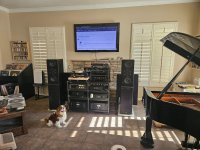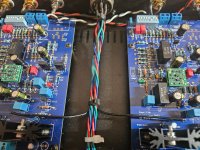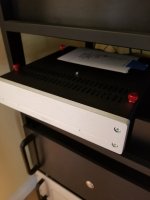Spent the time to get my 3 P3s very closely matched and compared them with general matching using the same R value. The main audible difference was a more precise center positioning in the soundstage -- but this was a very minor change. 6L6 has suggested just getting them in range is sufficient.
How important is to achieve a super-close match in the bias?
Not particularly important. It's mostly a fun thing to tweak. As Craig mentions, getting it in the recommended range is all that's needed.
@grataku has raised an interesting point above -- why are the boards so different in bias current? All 3 of mine show the same larger difference and each required the same R value set in order to get very close (560 and 600 as I remember). Not a fan of coincidence and think there must be an underlying reason.
The first thing that comes to mind is the J112 Idss mismatch.
One more thing as I put together the PS parts: what's the deal with the 'Quasimodo' to calc the snubber value? That's Mark Johnson's turf and I don't want to get creative. What are good, standard R1 R2 values for Tenma transformer?
What are good, standard R1 R2 values for Tenma transformer?
One more thing as I put together the PS parts: what's the deal with the 'Quasimodo' to calc the snubber value? That's Mark Johnson's turf and I don't want to get creative.
 What are good, standard R1 R2 values for Tenma transformer?
What are good, standard R1 R2 values for Tenma transformer?
Last edited:
Alrighty. I don't have a TT. Been slowly building this Pearl3 for a friend. Since I don't have a TT, had to figure out how to test it.
A little "You Spin Me Round (Like a Record)" by Dead or Alive seemed appropriate.
With inputs shorted, no measurable noise above the O-scope noise floor.
Even got signal on the balanced output pins.
I guess I can solder SMDs.

A little "You Spin Me Round (Like a Record)" by Dead or Alive seemed appropriate.
With inputs shorted, no measurable noise above the O-scope noise floor.
Even got signal on the balanced output pins.
I guess I can solder SMDs.
Thanks 6L6!Whatever you have in your box in the ballpark of 82 ohm.
That is assuming using the suggested 0.15uF for C4,5 right?
Hi 6L6, apologies, I don't know how the Amgis TE2253-ND transformer became -> Talema and then -> Tenma in my head...  .
.
Early onset..
 .
.Early onset..
Have done a modest amount of opamp rolling on the P3 (thank you, overly-generous 6L6!) and can report that the four opamps tried all made a discernible difference (typically in brightness and/or presence) and, after extended listening, the stock NJM2068D has always won out for my tastes.
The estimable Boydk brought to our attention the Sparkos Labs discrete opamps above; Andrew Sparks claims:
“IC op amps have shortcomings, like limited power dissipation and crummy compensation capacitors. Discrete op amps do not have these limitations, and are a vastly superior op amp for amplifying audio signals than their IC counterparts are. They can run much higher power, have much deeper class A bias, and deliver a much more realistic and detailed sound.”
So here they are installed on the P3 (cf. “DiOpAmp” below). Is Andrew Sparks correct in his assessment? Let's find out.
The audio system is largely DIY. A VPI Prime with Hana ML to the P3 (dual PSUs) to a BA2018 preamp (premium build with separate L/R attenuators and dual PSUs) to Aleph 30 monoblocks to Tekton Double Impact Speakers (cf. WinterSystem below). The ss3602 replaces the only IC used system wide (the P3 NJM2068D) – so any audio changes made by replacing an IC with discrete transistors will be most clear.
Next post: Classical test.
The estimable Boydk brought to our attention the Sparkos Labs discrete opamps above; Andrew Sparks claims:
“IC op amps have shortcomings, like limited power dissipation and crummy compensation capacitors. Discrete op amps do not have these limitations, and are a vastly superior op amp for amplifying audio signals than their IC counterparts are. They can run much higher power, have much deeper class A bias, and deliver a much more realistic and detailed sound.”
So here they are installed on the P3 (cf. “DiOpAmp” below). Is Andrew Sparks correct in his assessment? Let's find out.
The audio system is largely DIY. A VPI Prime with Hana ML to the P3 (dual PSUs) to a BA2018 preamp (premium build with separate L/R attenuators and dual PSUs) to Aleph 30 monoblocks to Tekton Double Impact Speakers (cf. WinterSystem below). The ss3602 replaces the only IC used system wide (the P3 NJM2068D) – so any audio changes made by replacing an IC with discrete transistors will be most clear.
Next post: Classical test.
Attachments
As a vehicle for assessing classical music reproduction, it doesn't get any better than Copland's “El Salon Mexico.” The best nationalist composer coupled with the great Bernstein who made a life's work of interpreting classical music for the people. Played by the New York Philharmonic at their height (“an army of generals”) and recorded by the best engineers when Columbia was in its prime (1970). Finish this off with a pristine analog vinyl pressing and you get a product screaming for audiophile enjoyment.
With the 2068D timbre is bright with sections and soloist types easily recognized. The soundstage is precise and depth is nicely evident with wind instruments, brass, and percussion heard towards the back. The famous bass drum wallops (3/4ths of the way through) are clearly heard and felt. Instruments are sharply etched and separated from each other with a great deal of “air” between them. Only minor criticisms are a very slight sense of dryness to the overall timbre and so much air that instruments can sound separated from the acoustic whole.
The ss3602 is much different. Overall noise level is slightly higher and record noise is more evident. Timbres are much more mellow with an emphasis on euphony rather than accuracy. Presence is poor by comparison to the 2068D and the bass timbre is significantly less accurate.
The biggest difference is in transparency. The Sparks ss3602 paints more of the total ensemble picture and instruments blend together in the soundstage without the2068D's sharp edge (and greater air). This can be a plus or minus depending upon your listening tastes. The ss3602 reminds you of audio systems from the 60s or 70s with a smooth evenness and accurate picture of the orchestra as a whole. But not the hyper-realism offered by more modern components.
So, round one goes to the 2068D for my tastes. The ss3602 is of interest because it is so different than the IC opamps tried out so far. It is deserving of some listening time by itself and this will be done this week.
Will add one additional post later this week discussing jazz and popular genres. Any comments from DIYers who have tried out the Sparks discrete opamp will be most appreciated.
With the 2068D timbre is bright with sections and soloist types easily recognized. The soundstage is precise and depth is nicely evident with wind instruments, brass, and percussion heard towards the back. The famous bass drum wallops (3/4ths of the way through) are clearly heard and felt. Instruments are sharply etched and separated from each other with a great deal of “air” between them. Only minor criticisms are a very slight sense of dryness to the overall timbre and so much air that instruments can sound separated from the acoustic whole.
The ss3602 is much different. Overall noise level is slightly higher and record noise is more evident. Timbres are much more mellow with an emphasis on euphony rather than accuracy. Presence is poor by comparison to the 2068D and the bass timbre is significantly less accurate.
The biggest difference is in transparency. The Sparks ss3602 paints more of the total ensemble picture and instruments blend together in the soundstage without the2068D's sharp edge (and greater air). This can be a plus or minus depending upon your listening tastes. The ss3602 reminds you of audio systems from the 60s or 70s with a smooth evenness and accurate picture of the orchestra as a whole. But not the hyper-realism offered by more modern components.
So, round one goes to the 2068D for my tastes. The ss3602 is of interest because it is so different than the IC opamps tried out so far. It is deserving of some listening time by itself and this will be done this week.
Will add one additional post later this week discussing jazz and popular genres. Any comments from DIYers who have tried out the Sparks discrete opamp will be most appreciated.
Oh, I put some thumbscrews on the P3 so I can roll amps more easily... I also got black ones ( which I put in the Burson Swing also for rolling op amps ) and silver ones.
But the red ones just looked... ahem... sexier?
The power supply box is below it, you can't see it in the picture. I build a little shelf that keeps them separate by three inches or so. No noise.
They are really nice boxes.... great job guys, thanks!
Just waiting for the balanced cable... hint.. when you order it, order two... not one... hmm....
But the red ones just looked... ahem... sexier?
The power supply box is below it, you can't see it in the picture. I build a little shelf that keeps them separate by three inches or so. No noise.
They are really nice boxes.... great job guys, thanks!
Just waiting for the balanced cable... hint.. when you order it, order two... not one... hmm....
Attachments
Thanks very much for the review @Craigl59
As I wrote in our PM´s, funds are not for bying expensive opamps right now (or else I would have already tried the Bursons V6-vivids) 🤣
Seems to me though, that what you describe, is what I get a lot of from the LME49720´s TO-99 version (without losing precision).
Far more mellow and less "harsh" than most of the others in affordable price range like NJM 4558, 4560, 4570, 4580, OPA2604, OPA2132/34 a.o.
I´m not talking "correctness" here but preferred taste, since I´m currently using/listening to the Asathor´s
Would probably have had a different opinion using my Maggie´s 3.6R´s, but unfortunately I blew a ribbon tweeter a while ago (yes.... it was
extremely loud) 😆
Thanks again for your comments. Also would like to know, if anybody in here has tried out any kind of Burson´s in their P-3.
As I wrote in our PM´s, funds are not for bying expensive opamps right now (or else I would have already tried the Bursons V6-vivids) 🤣
Seems to me though, that what you describe, is what I get a lot of from the LME49720´s TO-99 version (without losing precision).
Far more mellow and less "harsh" than most of the others in affordable price range like NJM 4558, 4560, 4570, 4580, OPA2604, OPA2132/34 a.o.
I´m not talking "correctness" here but preferred taste, since I´m currently using/listening to the Asathor´s
Would probably have had a different opinion using my Maggie´s 3.6R´s, but unfortunately I blew a ribbon tweeter a while ago (yes.... it was
extremely loud) 😆
Thanks again for your comments. Also would like to know, if anybody in here has tried out any kind of Burson´s in their P-3.
Boydk: did try the LME49720NA on the reccos above. It too lost out to the stock 2068. The ss3602s are not wearing well after additional listenings and will give them a few days then return to the stock 2068. Am using Burson opamps in two other amps and find them excellent. Will look into the V6-Vivids; height is, of course, a chassis issue with the tall Bursons.
Wouldn't have pegged you for a Maggie guy. Have got their entry level speakers in the garage and found they lost appeal over listening time (even with huge amounts of power). It was a lack of tone weight for me -- their accuracy was overshadowed by not enough body to make the listening experience visceral.
Wouldn't have pegged you for a Maggie guy. Have got their entry level speakers in the garage and found they lost appeal over listening time (even with huge amounts of power). It was a lack of tone weight for me -- their accuracy was overshadowed by not enough body to make the listening experience visceral.
Have a look at this thread: Blind test: opamp rolling in the Pearl 3 phonostage
There were some surprises
There were some surprises
@Craigl59, in what way did the 2068's sound better than the 49720's? I read your impressions of the 2068 and appreciate that, but how did they differ from the 49720's? In what way were the 49720's considered deficient? Thanks.Boydk: did try the LME49720NA on the reccos above. It too lost out to the stock 2068. The ss3602s are not wearing well after additional listenings and will give them a few days then return to the stock 2068. Am using Burson opamps in two other amps and find them excellent. Will look into the V6-Vivids; height is, of course, a chassis issue with the tall Bursons.
Wouldn't have pegged you for a Maggie guy. Have got their entry level speakers in the garage and found they lost appeal over listening time (even with huge amounts of power). It was a lack of tone weight for me -- their accuracy was overshadowed by not enough body to make the listening experience visceral.
- Home
- Amplifiers
- Pass Labs
- Pearl 3 Burning Amp 2023


